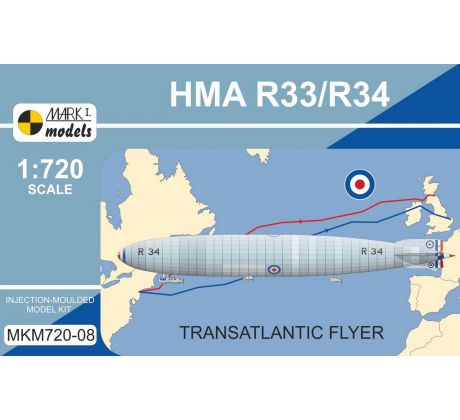HMA R33/R34 (Armstrong Whitworth R33/Beardmore R34) ‘Transatlantic Flyer’
 Mark I Models
Mark I Models Mark I Models 1:720
Mark I Models 1:720 HMA R33/R34 (Armstrong Whitworth R33/Beardmore R34) ‘Transatlantic Flyer’
HMA R33/R34 (Armstrong Whitworth R33/Beardmore R34) ‘Transatlantic Flyer’

HMA R33/R34 (Armstrong Whitworth R33/Beardmore R34) ‘Transatlantic Flyer’
Mark I Models 1:720
This injection-moulded kit contains 35 parts, including a useful model stand. A comprehensive instruction leaflet and a decal sheet are included.
Colour schemes included in the kit:
1) Armstrong Whitworth R33 (His Majesty’s Airship R33), c/n R33, Black R 33, Royal Navy/Royal Air Force, Pulham Airship Experimental Station, Norfolk, March – October 1919
2) Armstrong Whitworth R33 (His Majesty’s Airship R33), c/n R33, Black R 33/G-FAAG, Royal Air Force, Croydon Airport, summer 1921
3) Armstrong Whitworth R33 (His Majesty’s Airship R33), c/n R33, Black R 33/G-FAAG, civilian controlled by the National Physical Laboratory (NPL), Cardington Airship Station, Bedfordshire and Pulham Airship Experimental Station, Norfolk, April 1925 – November 1926
4) Beardmore R34 (His Majesty’s Airship R34), c/n R34, Black R 34, Royal Navy, East Fortune Airship Station, Scotland, performing the first double crossing of the Atlantic Ocean, July 1919
| Ref. No.: | MKM720-08 |
| Availability: | IN STOCK |
HMA R33/R34 (Armstrong Whitworth R33/Beardmore R34) ‘Transatlantic Flyer’
Description
Rigid airships were produced and relatively successfully employed in the period from the early 1900s to the end of the 1930s. The real technology trailblazer in this field was the Zeppelin company, of Imperial Germany, which built nearly one hundred military airships. British rigid airship designs lagged behind German developments, although a handful of ships were locally evolved and built.
Both the R33 and R34 were almost identical copies of the Zeppelin LZ76, which had been brought down intact onto the English soil in September 1916. Their structural metal frameworks were covered in doped fabric containing cells filled with hydrogen lifting gas. They were fitted with vertical tailfins and horizontal tailplanes with control surfaces. The crew members were carried in suspended gondolas mounting Sunbeam Maori engines and pusher propellers.
The R33 was built by Armstrong Whitworth and first flown in March 1919. By far Britain’s most successful rigid, it went on to serve successfully for ten years. It was used for experiments in connection with the design of the R101 airship and also for trials launching of parasite fighters. It was known as “Pulham Pigˮ.
Her sister ship, the R34, was constructed by Beardmore and also made her first flight in March 1919. She became the first aircraft to make an east to west transatlantic flight in July 1919 and by the return flight it completed successfully the first ever two-way crossing. The crew nicknamed her “Tinyˮ.
Products purchased together with this product
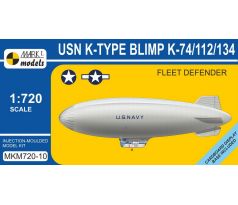
Goodyear K-type Blimp ‘Fleet Defender’
Mark I Models 1:720
This injection-moulded kit contains 17 parts, including a mobile mooring mast. A towing tractor (4 resin parts) is provided. For modeller’s convenience a display base, made of pasteboard card, depicting a section of the military airfield is added. A comprehensive instruction leaflet and a decal sheet are included.
Colour schemes included in the kit:
1) Goodyear ZNP-K-74 (K-type) Blimp, BuNo 30196, Blue K-74, Airship Patrol Squadron ZP-21/Blimp Squadron ZP-21 (Blimpron 21), Airship Patrol Group 2 (APG 2)/Fleet Airship Wing 2 (FASW 2), Fleet Airships Atlantic (FASA), US Navy, Naval Air Station Richmond, Det. NAS Key West, Florida, U.S.A., June/July 1943
2) Goodyear ZNP-K-112 (K-type) Blimp, BuNo 33504, Blue K-112, Blimp Squadron ZP-14 (Blimpron 14, “The Africa Squadron”), Fleet Airship Wing 1 (FASW 1), Fleet Airships Atlantic (FASA), US Navy, Craw Field, Naval Air Station Port Lyautey, French Morocco, North Africa, July 1944 and Cuers-Pierrefeu Naval Air Base (Base d’aéronautique navale, BAN), Var Department, France, September/October 1944
3) Goodyear ZNP-K-134 (K-type) Blimp, BuNo not received, Blue K-134, Blimp Squadron ZP-14 (Blimpron 14, “The Africa Squadron”), Fleet Airship Wing 1 (FASW 1), Fleet Airships Atlantic (FASA), US Navy, Craw Field, Naval Air Station Port Lyautey, French Morocco, North Africa, summer 1944 and La Sénia airfield, Oran, Algeria, North Africa, December 1944
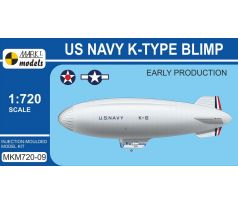
Goodyear K-type Blimp ‘Early Production’
Mark I Models 1:720
This injection-moulded kit contains 17 parts, including a mobile mooring mast. A towing tractor (4 resin parts) is provided. For modeller’s convenience a display base, made of pasteboard card, depicting a section of the military airfield is added. A comprehensive instruction leaflet and a decal sheet are included.
Colour schemes included in the kit:
1) Goodyear ZNP-K-3 (K-type) Blimp, BuNo 7025, Blue K-3, Airship Patrol Squadron ZP-12, Airship Patrol Group 1 (APG 1), US Navy, Naval Air Station Lakehurst, New Jersey, U.S.A., early 1942
2) Goodyear ZNP-K-6 (K-type) Blimp, BuNo 7028, Blue K-6, Airship Patrol Squadron ZP-12, Airship Patrol Group 1 (APG 1), US Navy, Naval Air Station Lakehurst, New Jersey, U.S.A., spring 1942
3) Goodyear ZNP-K-28 (K-type) Blimp, BuNo 04378, Blue K-28, Blimp Squadron ZP-24 (Blimpron 24), Fleet Airship Wing 1 (FASW 1), Fleet Airships Atlantic (FASA), US Navy, Naval Air Station Weeksville, North Carolina, U.S.A., summer 1944
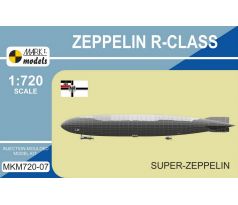
Zeppelin R-class ‘Super-Zeppelin’
Mark I Models 1:720
This injection-moulded kit contains 49 parts, including a useful model stand. A comprehensive instruction leaflet and a decal sheet are included.
Colour schemes included in the kit:
1) Zeppelin LZ75 (R-class), L37, Black L37, Naval Airship Division (Marine-Luftschiff-Abteilung), Imperial German Navy (Kaiserliche Marine), Seerappen Airship Base, spring 1917
2) Zeppelin LZ80 (R-class), L35, Black L35, Naval Airship Division (Marine-Luftschiff-Abteilung), Imperial German Navy (Kaiserliche Marine), Jüterbog Airship Base, Germany, February 1917
3) Zeppelin LZ80 (R-class), L35, White L35, Naval Airship Division (Marine-Luftschiff-Abteilung), Imperial German Navy (Kaiserliche Marine), Jüterbog Airship Base, Germany, June 1917
4) Zeppelin LZ85 (R-class), L45, Naval Airship Division (Marine-Luftschiff-Abteilung), Imperial German Navy (Kaiserliche Marine), Tøndern Airship Base, Denmark, spring 1917
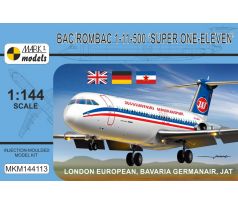
BAC/Rombac 1-11-500 ‘Super One-Eleven’ London European, Bavaria Germanair, JAT
Colour schemes included in the kit:
1) Rombac (BAC) 1-11-500 (561RC), G-BNIH (ex-YR-BRF, c/n 406), London European Airways Plc. (a/c leased from Tarom), Luton Airport, Bedfordshire, U.K., 1987-90
2) British Aircraft Corporation BAC 1-11-500 (524FF), D-AMOR (c/n 197), Bavaria Germanair GmbH, Munich-Riem Airport, Bavaria, West Germany, 1977-78
3) Rombac (BAC) 1-11-500 (561RC), YR-BRA (c/n 401), JAT Yugoslav Airlines/Jugoslovenski Aerotransport (a/c leased from Tarom), Belgrade Airport, Yugoslavia, 1989
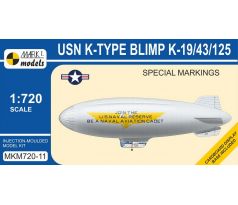
Goodyear K-type Blimp ‘Special Markings’
Mark I Models 1:720
This injection-moulded kit contains 17 parts, including a mobile mooring mast. A towing tractor (4 resin parts) is provided. For modeller’s convenience a display base, made of pasteboard card, depicting a section of the military airfield is added. A comprehensive instruction leaflet and a decal sheet are included.
Colour schemes included in the kit:
1) Goodyear ZPK-19 (K-type) Blimp, BuNo 04369, Black K-19, Blimp Squadron ZP-2, Fleet Airship Wing 1 (FASW-1), US Navy, Naval Air Station Lakehurst, New Jersey, U.S.A., seen during the first official celebration of Armed Forces Day at Annapolis, Maryland, on 20 May 1950
2) Goodyear ZSG-3-43 (K-type) Blimp, BuNo 30165, Black 43, Blimp Squadron ZP-2, Fleet Airship Wing 1 (FASW-1), US Navy, Naval Air Station Lakehurst, New Jersey, U.S.A., recorded during a recruiting circle trip, NAS Moffett Field, California, December 1955
3) Goodyear ZSG-3-125 (K-type) Blimp, BuNo not received, Black K-125, Reserve Patrol Squadron ZP-951, Naval Air Reserve Training Unit (NARTU), LTA (Lighter Than Air), US Navy, Marine Corps Air Facility, Santa Ana, California, U.S.A., summer 1955
Last seen productsCancel history
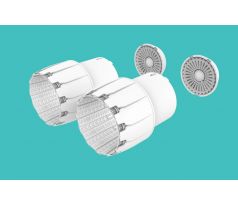
B-1b LANCER EXHAUST Early OPEN
1/144 scale 3D resin printed parts of Exhaust Early OPEN option for B-1b Lancer, design for Academy kit. Includes color instructions. Set contain parts for make one model.

